|

Géologiquement parlant, le Trégor est surtout connu pour le complexe granitique de Ploumanac'h correspondant à la Côte de Granite Rose. Il a été formé par l'intrusion de bulles magmatiques dans un encaissant plus ancien que l'on retrouve en périphérie du complexe, formé principalement de trois type de roches: les cornéennes de l'île Milliau, le pluton granitique de Perros-Guirec et le gneiss de Trébeurden. Ce dernier est notamment visible dans l'anse de Pors Raden où affleurent les plus vieilles roches de France.
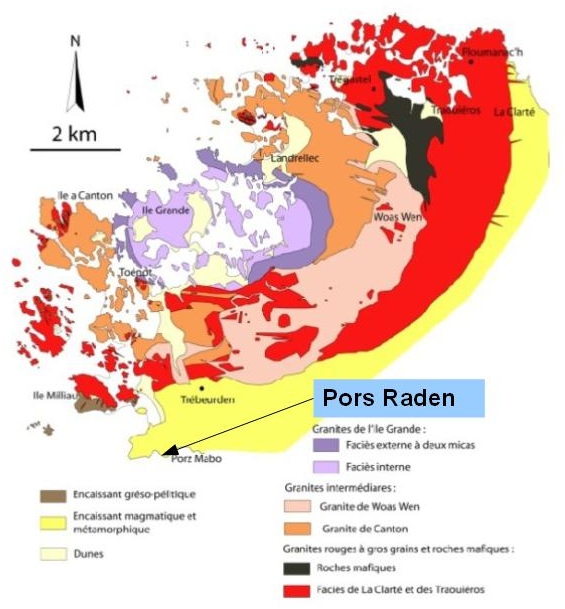
L'orthogneiss icartien de Pors-Raden
Ce gneiss oeillé, contenant des inclusions de feldspath (zones plus claires que la matrice), est issu d'un protolithe granitique, ayant subit d'intenses déformations et métamorphoses : c'est donc un orthogneiss. Il fait partie d'un ensemble dit icartien que l'on retrouve également dans l'anse de Port Béni à Pleubian et dans la baie d'Icart à Guernesey, à l'origine du qualificatif. Cet ensemble s'est formé il y a plus de 2 milliards d'années (2 Ga), presque la moitié de l'age de la Terre estimé à 4,57 milliards d'années.
La datation des gneiss
Les datations géologiques peuvent se faire de deux façons, la datation relative qui positionne différentes couches entre elles pour reconstruire la succession des évênements géologiques ou la datation absolue qui détermine l'âge d'un matériau en se basant sur ses propres propriétés physiques ou chimiques. Parmi les méthodes de datation absolue, la radiométrie, basée sur les processus de radioactivité, est la plus utilisée. En fonction des types de roches et de leur âge présumé, plusieurs types d'analyse sont possibles utilisant différents atomes : uranium/plomb (U/Pb), samarium/néodymium (Sm/Nd), potassium/argon (K/Ar), rubidium/strontium (Rb/Sr), uranium/thorium (U/Th) ou carbone 14 (réservée aux résidus d'organismes vivants). A Pors-Raden, un datation U/Pb appliquée à des petits fragments de zircon inclus dans la roche a permis d'estimer l'âge du gneiss à 2031 millions d'années avec une incertitude de +36/-28 M.
Pour déterminer l'age de roches aussi anciennes, il est en effet courant d'utiliser le zircon, un minéral aux propriétés exceptionnelles. Il s'agit d'un silicate de zirconium naturel ZrSiO4, qui cristallise avec une dureté de 6,5 à 7,5 et reste stable dans des conditions de très hautes températures et pressions : il peut donc traverser de très longues périodes géologiques en restant inaltéré, jouant ainsi un rôle de témoin. Les diamants sont peut-être éternels mais sur Terre, les zircons sont les plus vieux cristaux connus (4,4 milliards d'années, région des Jack Hills en Australie).
Comme l'uranium peut se substituer au zirconium et donc être présent à l'état de traces dans la roche, le zircon est un candidat idéal pour des datations radiométriques utilisant de l'uranium radioactif.
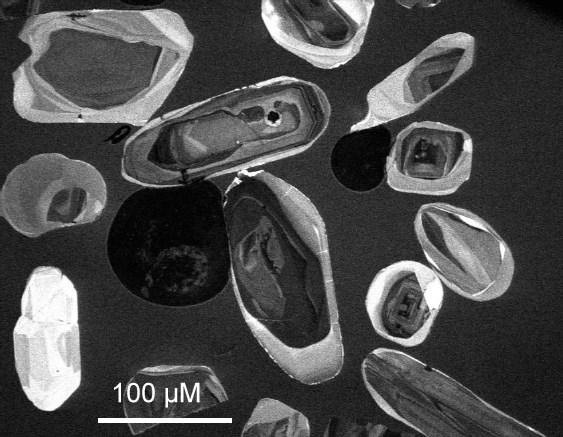
La radioactivité de l'uranium
A l'état naturel, l'uranium est principalement constitué de deux isotopes radioactifs, U235 (99,27%) et U238 (0,72%). Ces isotopes se décomposent en d'autres atomes par émission de particules α (2 protons et 2 neutrons) et de particules β- (1 électron provenant de la transformation d'un neutron en proton). Un corps radioactif est caractérisé par sa demi-vie, la durée au bout de laquelle la moitié de la masse initiale s'est désintégrée par émission de rayonnement, créant de nouveaux atomes. La demi-vie de l'U238 est de 4,468 milliards d'années et celle de l'U235 de 704,8 millions d'années.
Si les atomes produits sont eux-mêmes radioactifs, le processus peut se répéter plusieurs fois jusqu'à l'obtention d'atomes non radioactifs. Par exemple, l'uranium U238 se transforme en plomb Pb206 en passant par de nombreuses étapes successives :U238 , Th234, Pa234, U234, Th230, Ra226, Rn222, Po218, Pb214, Bi214, Po214, Pb210, Bi210, Po210, Pb206 (Th: thorium, Pa : protactinium, Ra : radium, Rn : radon, Po: polonium, Bi : bismuth). Par des étapes similaires, l'uranium U235 se transforme lui en plomb Pb207.
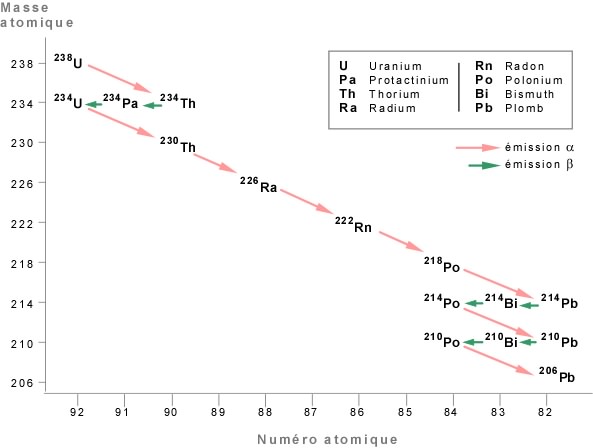
Les atomes intermédiaires étant instables et se désintégrant beaucoup plus rapidement que les isotopes d'uranium de départ (demi-vies de quelques minutes à 250 000 ans), on peut considérer que la demi-vie d'un isotope stable d'uranium correspond au temps nécessaire pour que la moitié de la masse initiale se transforme en plomb.
La radioactivité d'une quantité N d'un isotope pendant une période infinitésimale dt peut se mesurer par la quantité de matière transformée dN, proportionelle à la quantité de départ. On a donc dN = -λ.N.dt
La loi décrivant l'évolution de N en fonction du temps est l'intégrale de cette équation différentielle, c'est une loi de décroissance exponentielle : N(t) = N0.exp(-λ.t) , N0 étant la quantité initiale de l'isotope. On peut relier λ et la demi-vie en calculant le moment T1/2 où la moitié de la quantité initiale a disparu : N(T1/2) = N0/2 = N0.exp(-λ.T1/2) donc 1/2 = exp(-λ.T1/2) et T1/2 = ln(2)/λ (ln étant le log népérien).
En reprenant les valeurs des demi-vies des isotopes d'uranium, on obtient
T1/2(235U) = 0,707 109 années et donc λ(235U) = 9.849 10-10/années
T1/2(235U) = 4,47 109 années et donc λ(238U) = 1.551 10-10/années
En négligeant les étapes intermédiaires, on peut considérer que tout atome d'uranium qui disparaît se transforme in fine en un atome de plomb.
NU0 + NPb0 = NU(t) + NPb(t)
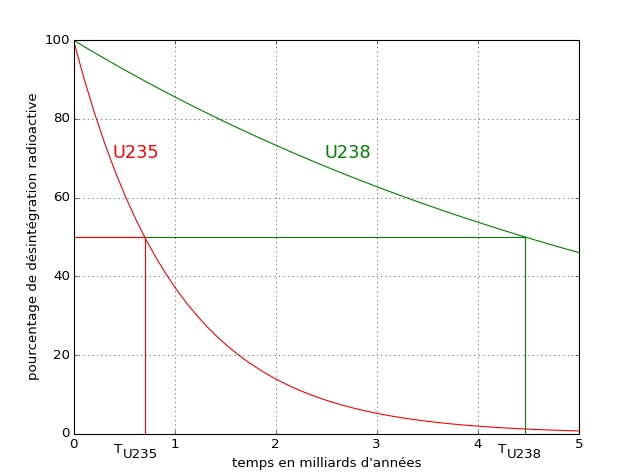
La datation U/Pb
Si on suppose que le cristal de zircon ne contenait pas de plomb au départ et que le système est resté "fermé", c'est-à-dire qu'il n'y a eu ni fuite de d'uranium ou de plomb, ni arrivée de matière nouvelle, phénomène possible au c&oe;ur d'un zircon, on a:
NU(t) = N0 - N0exp(-λt)
NPb(t) = N0exp(-λt)
NPb(t)/NU(t)= exp(λ.t) - 1
Donc en mesurant le rapport entre les quantités résiduelles de Plomb 206 et d'Uranium 238 ou de Plomb 207 et d'Uranium 235, on peut déterminer l'age de la cristalisation du zircon.
Dans la réalité, c'est un peu plus compliqué car il peut y avoir du plomb présent à la formation du cristal ou il peut y avoir eu des évènements géologiques faisant que l'on ne peut plus considérer que le système est resté fermé. On utilise alors un diagramme de concordance ("concordia") dont les coordonnées sont les rapports NPb206/NU238 et NPb207/NU237. C'est ce type de diagramme qui a notamment été utilisé pour les mesures faites sur les plus vieux zircons du monde.
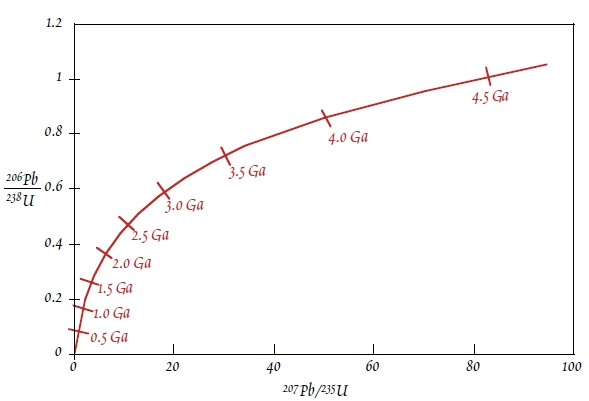
Les grains de zircons, en général des prismes de 100 à 200 microns, sont sélectionnés au microscrope à l'issue d'une phase de concassage de la roche initiale et d'une séparation des différents composants. Les mesures sont alors faites avec un spectromètre de masse, après une étape de dilution des isotopes ou une vaporisation par laser ou par mesure des ions secondaires provoqué par un faisceau d'ions initial.
Validation de la cache
L'accès à la zone de la cache peut se faire en partant de Pors Mabo soit en suivant l'estran sur les rochers soit en suivant le sentier côtier vers l'ouest jusqu'à une descente en escalier (départ au point PT) qui rejoint directement l'anse de Pors Raden. L'accès à la zone de la cache dépend des coefficients de marée.
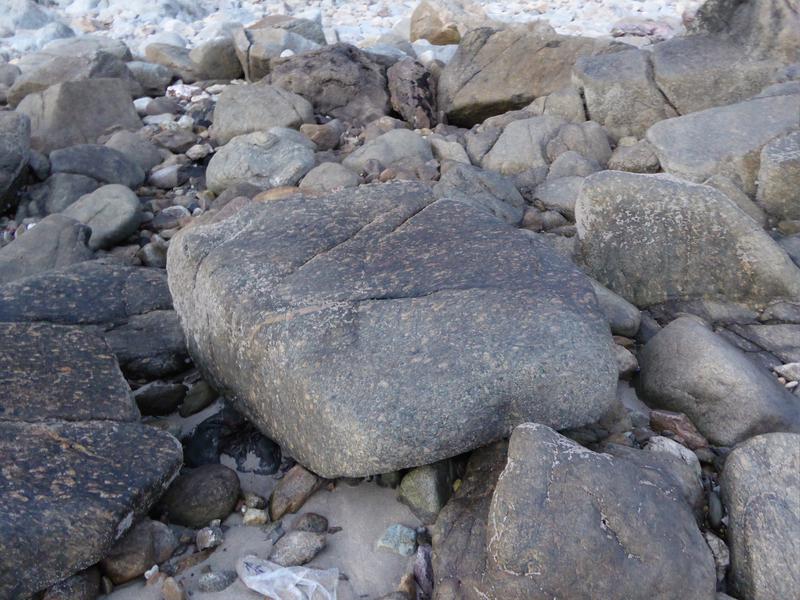
Pour valider la cache vous devez envoyer les informations suivantes (vous pouvez en parallèle publier votre visite):
- La longueur approximative des cotés du bloc carré de la photos ci-dessus à l'endroit de la cache
- La taille approximative des plus gros "yeux" de feldspath présents dans les gneiss situés à l'endroit de la cache
- Les rapports Pb206/U238 et Pb207/U235 atteints au bout de 2 milliards d'années (l'âge des gneiss de Pors Raden)
En prime, si vous le pouvez, merci de prendre en photo la Roche Mignone, un îlot composé de microgranite situé à quelques centaines de mètres au sud ouest, pour illustrer l'état de la marée et les conditions météorologiques lors de votre visite.
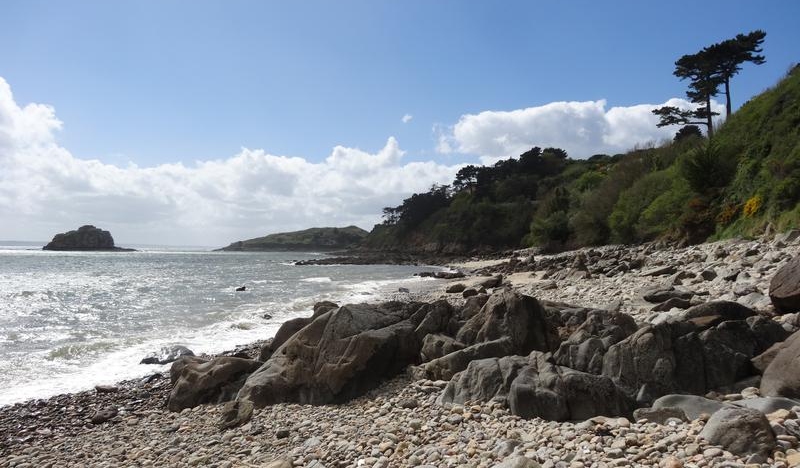
On the oldest rocks in France

In geology, the Trégor is mostly known for the granitic complex of Ploumanac'h, touristically known as Pink Granite Coast. It was formed by the intrusion of hot magma in older rock layers than can be observed at the periphery of the complex : the cornean shales ??? on the Milliau Island, the granitic pluton of Perros Guirec and the gneiss in Trébeurden. The later is better experienced on the Pors Raden cove where surface the oldest rocks in France.

Icartian orthogneiss of Pors Raden
This augen gneiss, with inclusions of feldspar (eye shaped zones lighter colored than the matrix), was formed by the transformation of a granitic protolith : it's an orthogneiss. It's part of the Icartian basement than can be also found in the Port Béni bay in Pleubian and in the Icart bay in Guernesey (thus the name). It formed more than 2 billion years ago (2Ga), almost half the age of Earth estimated at 4,57 billion years.
Datation of the gneiss
Geological datations can be done two ways : the relative datation than use the position of different layers to infer the geological history of the rocks aand the absolute datation that estimate the age of a given material using its own physical or chemical properties. Among absolute datation methods, radiometry, based on radioactivity, is mostly used. According on the type of rocks used and their estimated age, several analysis are available : uranium/lead (U/Pb), samarium/neodymium (Sm/Nd), potassium/argon (K/Ar), rubidium/strontium (Rb/Sr), uranium/thorium (U/Th) or carbon 14, the later being used for the remains of organic nature. In Pors Raden, a U/Pb datation applied to small fragments of zircons in the gneiss resulted in an age of 2031 million years +36/-18 million years.
To measure the age of such old rocks, it is usual to use zircons, a mineral with exceptionnal properties. It's a natural zirconium silicate ZrSi04, which cristallize with a hardness of 6,5 to 7,5 that remains stable under very high temperatures and pressures for very long periods of time, acting as a witness of ancient events. Diamonds are forever but on Earth, zircons, often used as diamond substitutes for jewels, are the oldest known cristals (4,4 billions years, in the Jack Hills area in Australia).
As uranium atoms can take the place of zirconiums atoms in cristals, zircons are the ideal candidates for radiometric datation based on radioactive uranium.

Uranium radioactivity
In nature, deux radioactive isotopes of uranium are mostly found, U235 (99,27%) and U238 (0,72%). These isotopes degrade in other atoms with the emission of α particles (alpha, 2 protons and 2 neutrons) or β particles (beta, 1 electron produced by the transformation of one neutron to a proton). A radioactive material is caracterized by it half life, the delay after which half the initial mass of isotope disintegrated, emitting particuls and creating new atoms. The half life of U238 is 4,468 billion years and those of U235 is 704,8 millions years.
When the new atoms produced are radioactive themselves, the desintegration process can repeat several time before producing stable non radioactive isotopes. For example U238 can transform into lead Pb206 through several steps : U238 -> Th234 -> Pa234, ??? U234, Th230, Ra226, Rn222, Po218, Pb210, Bi210, Po210, Pb206 (Th : thorium, Pa : protactinium, Ra : radium, Rn : radon, Po : polonium, Bi : bismuth). A similar process transforms uranium U235 into lead Pb207.

The intermediary atoms being instable and disintegrating ??? much more rapidly than the original uranium atoms (half lives ranging from a few minutes to a few hundred thousands years), one can estimate with approximation over geological times that the half life of uranium (U235 or U238) is the time necessary to transform half its atoms in lead atoms.
The radioactivity of a quantity N of an isotope during a short infinitesimal ??? period dt is measured by the quantity dN of material that transformed itself, that is proportional with the initial quantity. Thus dN = -λ.N.dt
The law describing the evolution of N over time is the integral of the differential equation, it's an exponential decrease N(t) = N0.exp(-λ.t) , N0 being the initial quantity of the isotope. One can calculate the relation between the half-life T1/2 and λ : N(T1/2) = N0/2 = N0.exp(-λ.T1/2) thus 1/2 = exp(-λ.T1/2) and T1/2 = ln(2)/λ (ln being the népérien log).
Applied to the two uranium isotopes, that gives :
T1/2(235U) = 0,707 109 years and λ(235U) = 9.849 10-10/years
T1/2(235U) = 4,47 109 years and λ(238U) = 1.551 10-10/years
Neglecting the intermediary step, each uranium atom that disappears become a lead atom in the end.
NU0 + NPb0 = NU(t) + NPb(t)

La datation U/Pb
With the hypothesis that the zircon didn't included any lead at the beginning and that the system remained closed (neither leak or arrival of any outside uranium or lead), hypothesis that reasonable for the core zone of a zircon fragment included in gneiss, that gives:
NU(t) = N0 - N0exp(-λt)
NPb(t) = N0exp(-λt)
NPb(t)/NU(t)= exp(λ.t) - 1
Thus, by measuring the ratio between the remaining quantities of Lead 206 and Uranium 238 or of Lead 207 and Uranium 235, on can evaluate the age of the zircon's cristallization.
In reality, it's a bit more complicated as there may be some lead when the cristal was created or some later geological events may invalidate the closed system hypothesis. In that case, a concordance diagram ("concordia") is used, charting the ratio NPb206/NU238 against NPb207/NU237. That kind of diagram was used to evaluate the age of the oldest zircons on Earth.

The small fragments of zircon, generally prisms with a diameter of 100 to 200 microns, are selected using a microscope after breaking down the gneiss and seperating the different components. The measures are then performed with a mass spectromer, after diluting the isotopes or vaporising then with a laser or by measuring secondary ions created with a high energy beam of other ions.
Validating the cache
Starting from Pors Mabo (closest car park), the cache area can be reached along the sea coastal line, climbing on rocks or following the hiking coastal path to the west then doing down some stairs (starting at point PT) to go directly to Pors Raden cove. The cache area may not be accessible on some high tides.

To validate the cache, please send the following informations (you can log in parallel):
- The length of a side of the square shaped block at the center of the previous picture, taken at the cache location
- The approximate size of the feldspath eyes in the gneiss at the cache location
- The ratio Pb206/U238 and Pb207/U235 reached after 2 billions years (the age of Pors Raden gneiss).
As a bonus, please take a picture of the Roche Mignone, the islet of microgranite in the south west direction, to show the tide level and the meteorological conditions when searching the cache.

Bibliographie et iconographie/Bibliography and iconography
- "Notice explicative de la feuille Lannion à 1/50 000" par J. Chantraine (coordinateur), E. Houlgatte, L. Chauris, E. Le Goff, C. Coussement, J. Garreau, C. Larsonneur, A. Carn - BRGM 1999 [ficheinfoterre.brgm.fr/Notices/0203N.pdf]
- Lecture notes Earth and Atmospheric Sciences 656 "Isotope Geochemisty" - Cornell University - 2011 [www.geo.cornell.edu/geology/classes/Geo656/656home.html]
- "Géotourisme en Côtes-d'Armor : petit guide géologique pour tous" par Pierrick Graviou - Editions Biotope - 2012 [www.biotope-editions.com/index.php?article36/geotourisme-en-cote-d-armor]
- "Ploumanac'h, joyau géologique du Trégor: le magmatisme composite du complexe granitique de Ploumanac'h" par Jean Plaine - Université Rennes 1 - 2004 [sgmb.univ-rennes1.fr/geotopes/decouvertes/23-decouvertes/67-ploumanac-h]
- "Promenade géologique dans le granite de Ploumanac'h et son encaissant" par Nicole Santarelli - Société Amicale des Géologues Amateurs - 2012 [www.saga-geol.asso.fr/Geologie_page_conf_Ploumanach.html]
- Wikipedia articles Portail des Sciences de la Terre et de l'Univers Portal on Earth Sciences
- Planète Terre par Pierre-André Bourgue, Département de Géologie et de Génie Géologique - Université de Laval, Québec [www2.ggl.ulaval.ca/personnel/bourque/s4/datations.radiometriques.html]
|